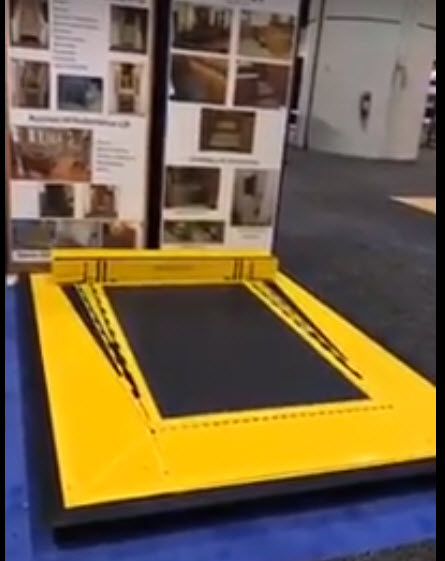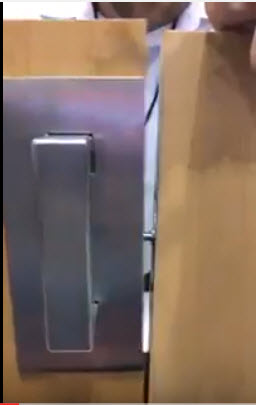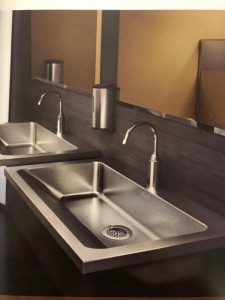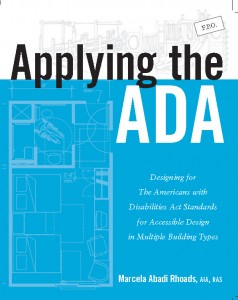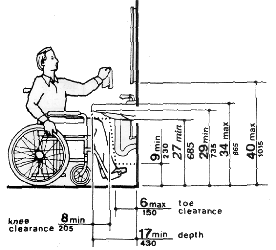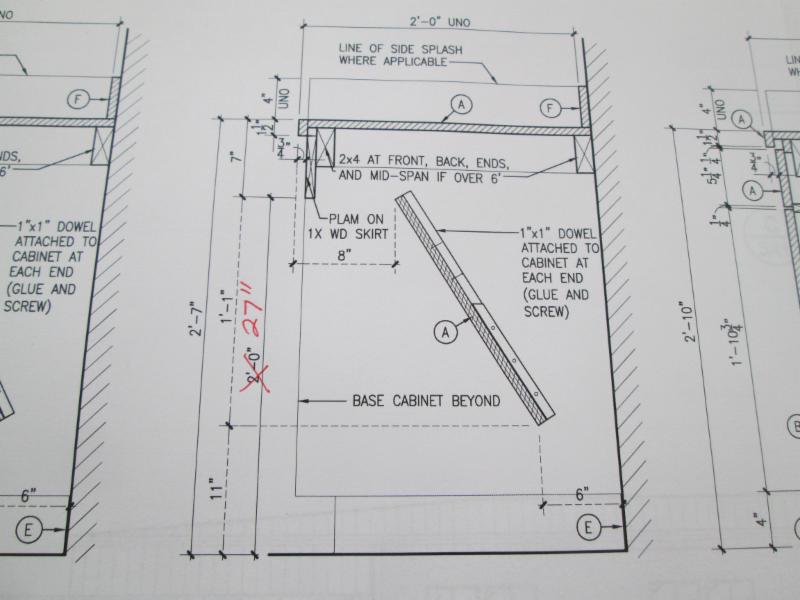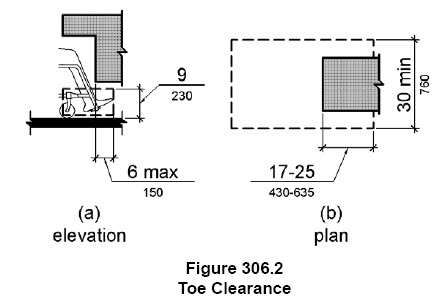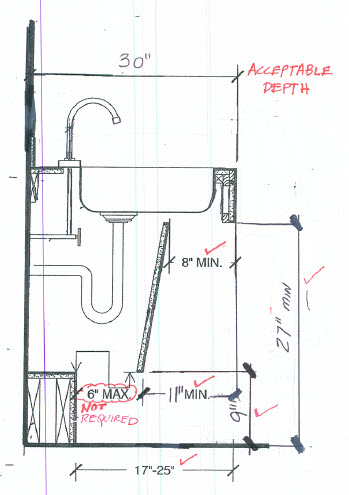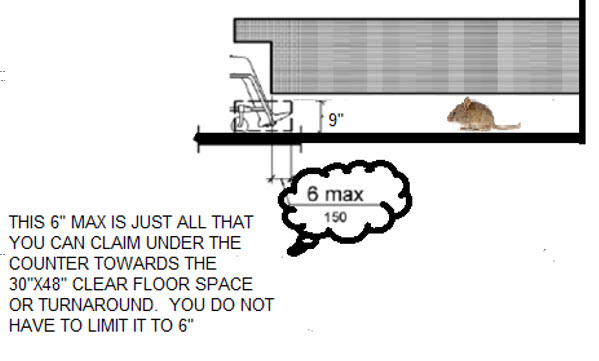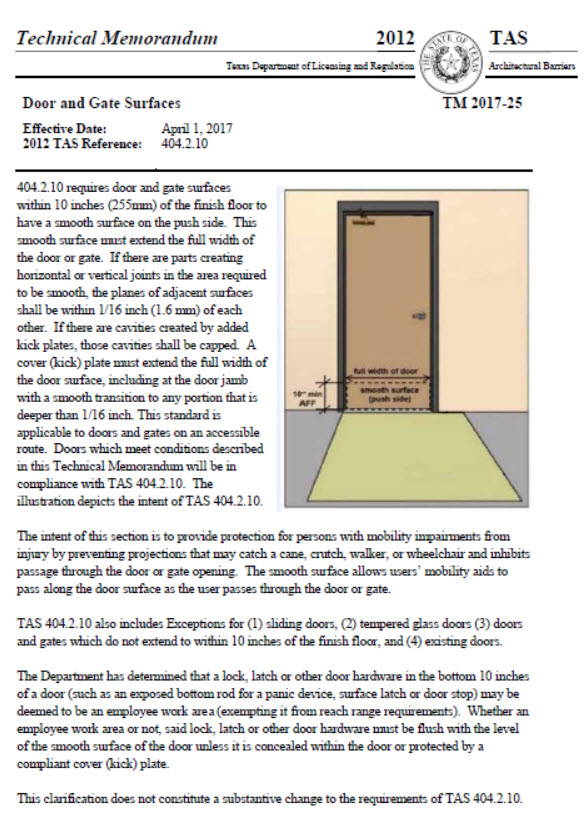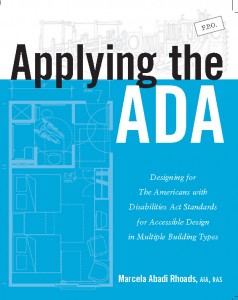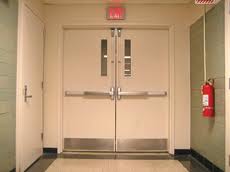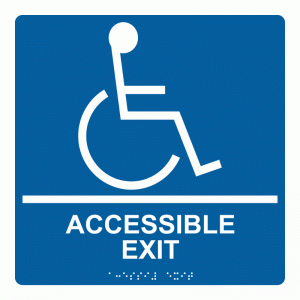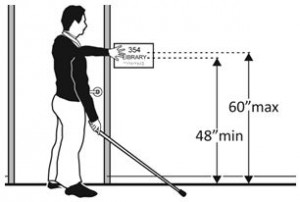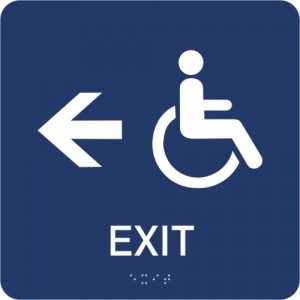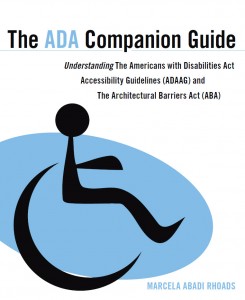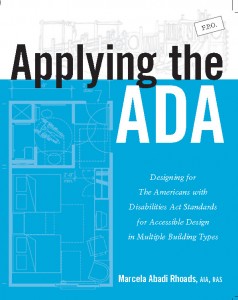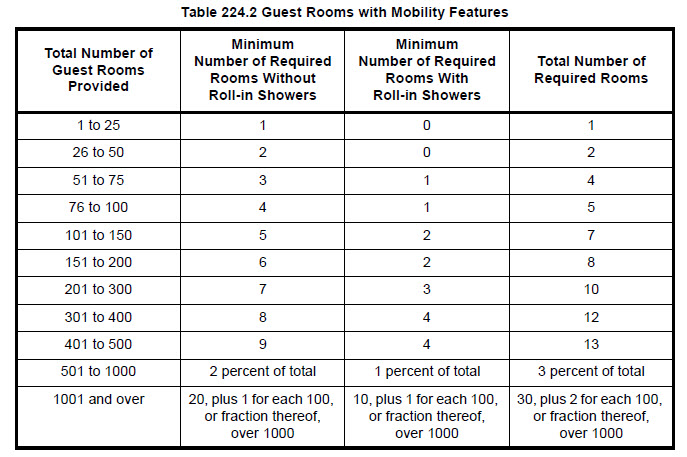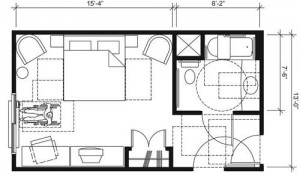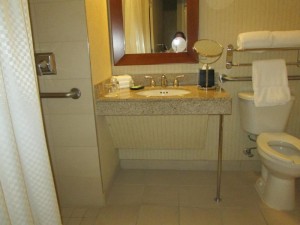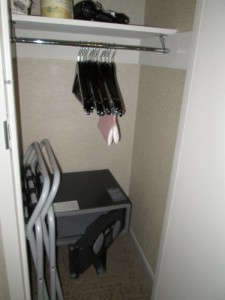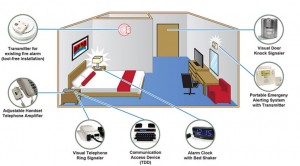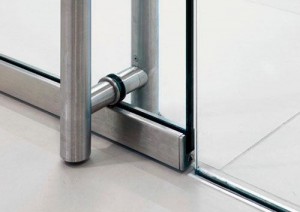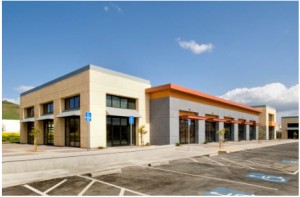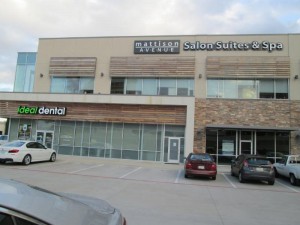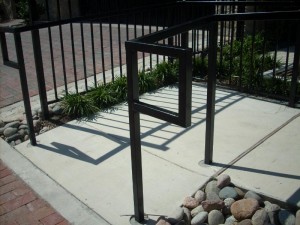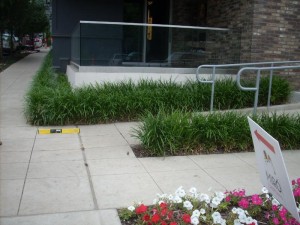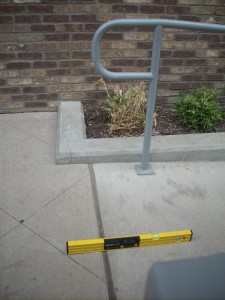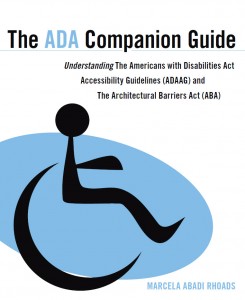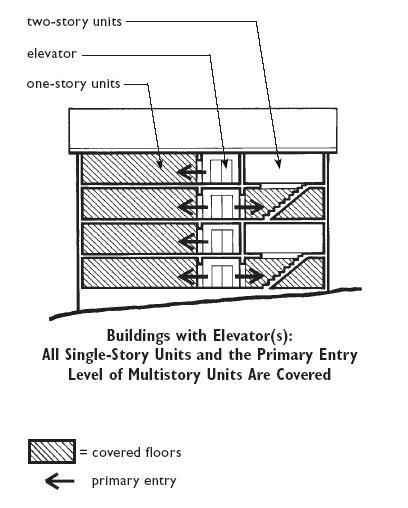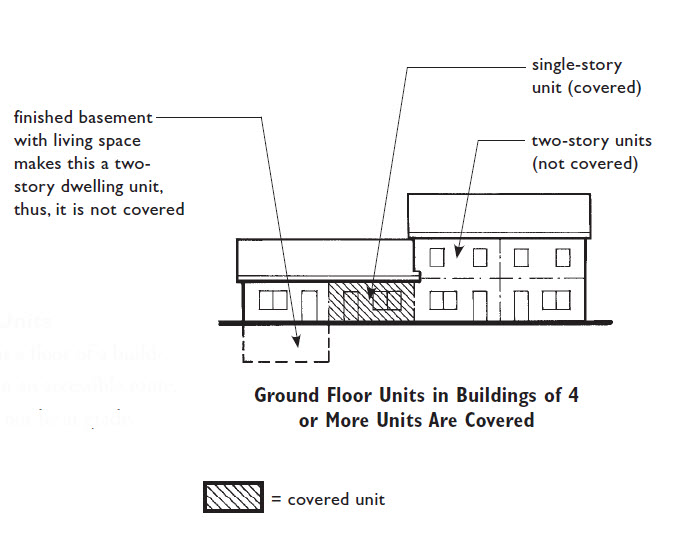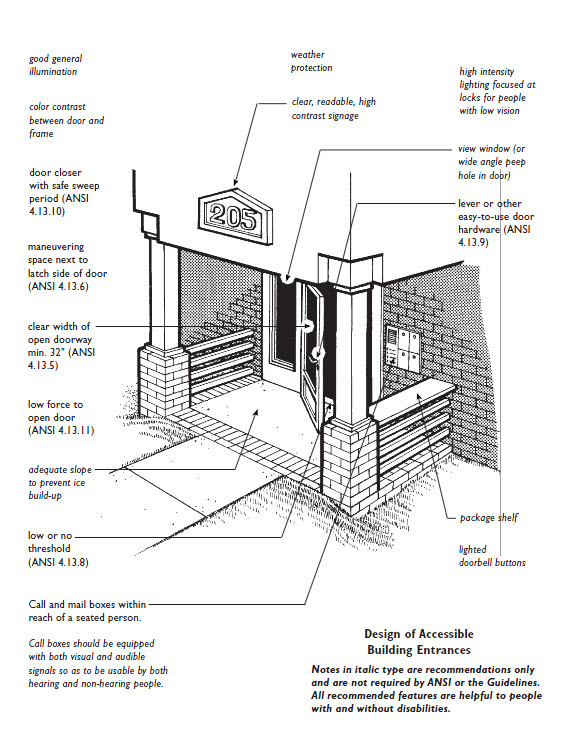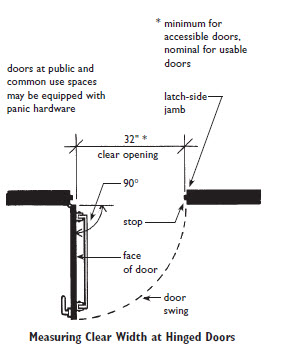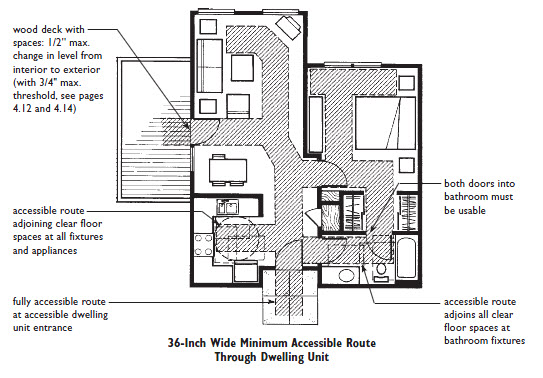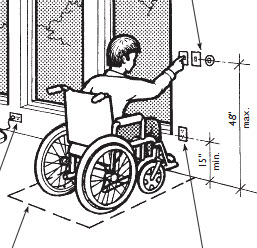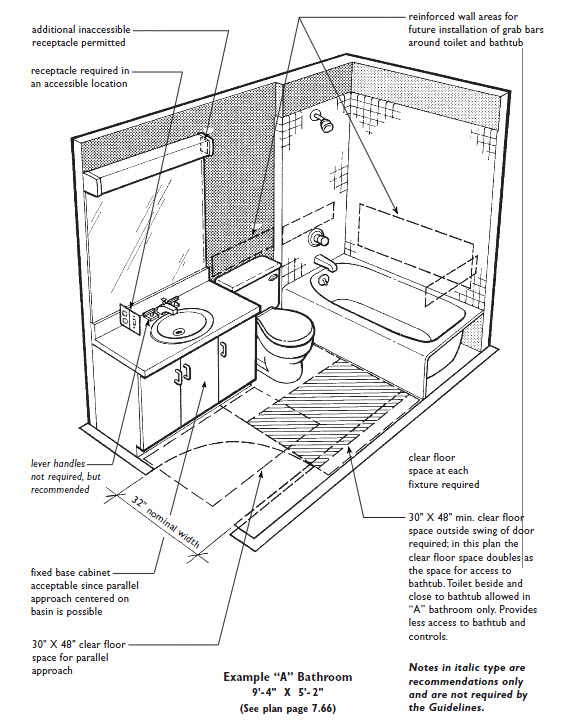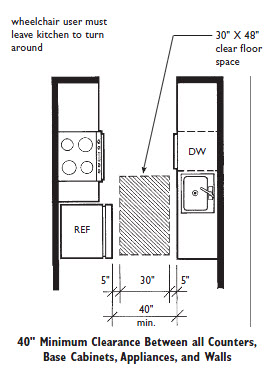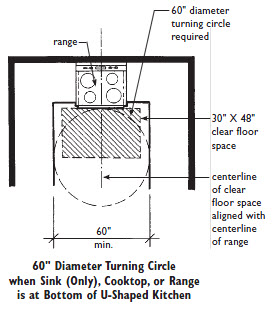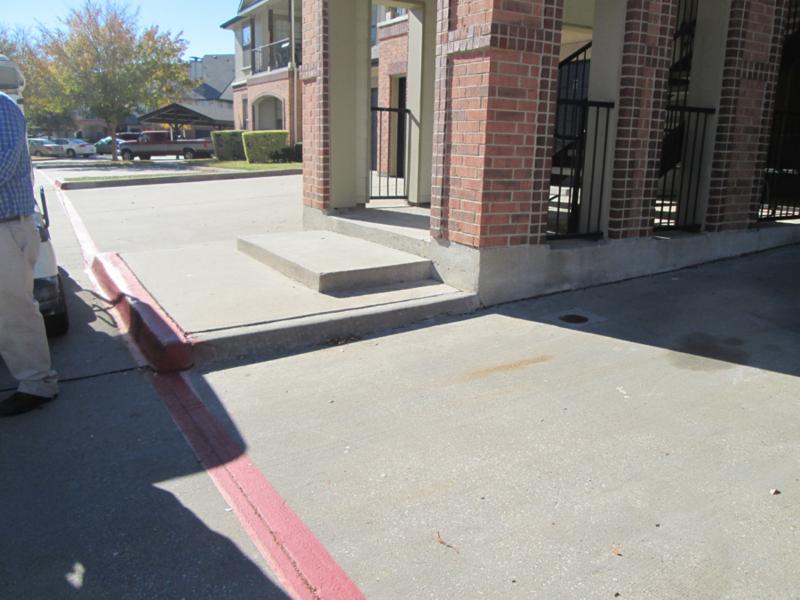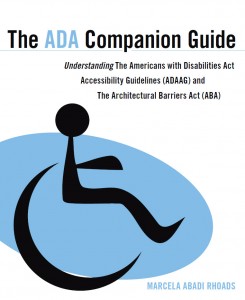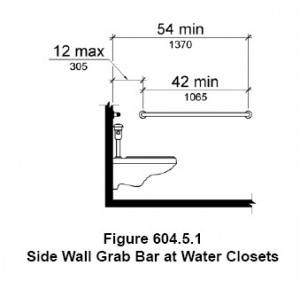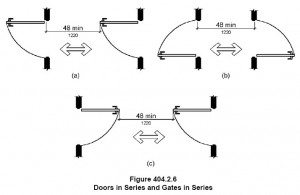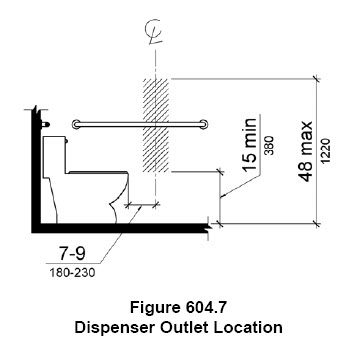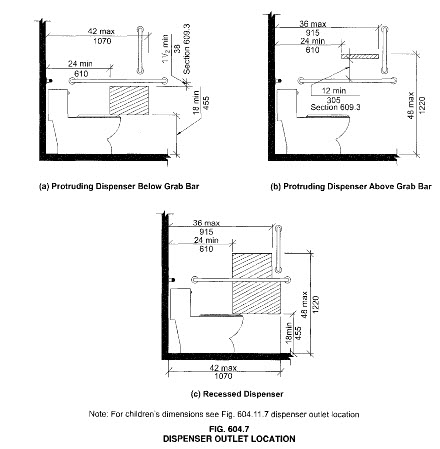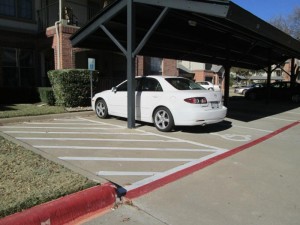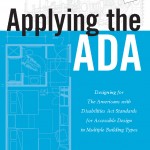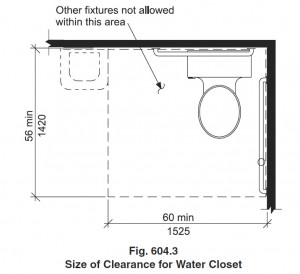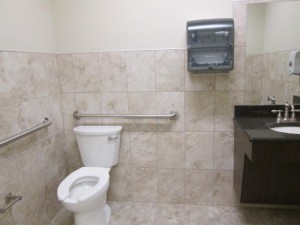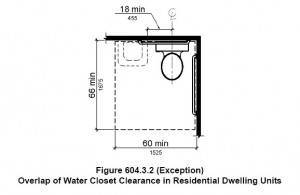In the 2010 ADA Standards, the side wall grab bars are required to be horizontal per the figure below
ANSI A117.1 , in addition to the horizontal grab bar, it requires a vertical grab bar at the side wall.
In the ADA, a set of doors in series has a certain dimension between the two doors.
The ANSI Standards is more flexible on the position, and gives the designer more options
There is a lot of confusion in the ADA on what clearances and elements are allowed to overlap each other. The main idea for restrictions to having elements overlap is the inability for a person in a wheelchair to use the element or the space efficiently. The amount of clearance that we design by translates to the amount of space that should be provided for one wheelchair. Floor clearances are not fixed elements and if they overlap each other it does not impede the usage of the clearance. But if a fixed element overlaps the clearance, that might reduce the clearance and prevents a person from using the element.
This newsletter will explain which elements can overlap since they don’t impede the usage of the space or element, and which ones may not overlap. All the rulings are taken from the 2010 ADA Standards
Door Swings
The ADA allows a door to swing into the turning space.
304.4 Door Swing. Doors shall be permitted to swing into turning spaces.
The turning space is not a fixed object. It essentially can move anywhere in a space. Therefore the door swing is not required to avoid it. It can swing into it as much as it needs to.
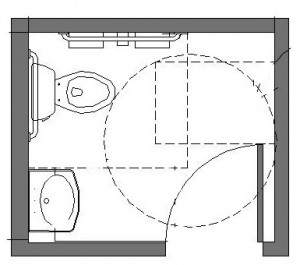
The ADA The plan of the restroom shows a door swinging into the turning space.
But a door may not swing into the clearance of a plumbing fixture or any fixture within the toilet room. This ensures that if a person in a wheelchair is washing their hands at a lavatory near the door that swings into the toilet room, that person will not get hit by the door.
603.2.3 Door Swing. Doors shall not swing into the clear floor space or clearance required for any fixture. Doors shall be permitted to swing into the required turning space.
There are a couple of exceptions. If the the toilet room is a private office or a single user restroom, it is assumed that the person inside will lock the door behind them and therefore the chances of getting hit by a door while using a fixture that is located within the door swing is unlikely.
EXCEPTIONS:
1. Doors to a toilet room or bathing room for a single occupant accessed only through a private office and not for common use or public use shall be permitted to swing into the clear floor space or clearance provided the swing of the door can be reversed to comply with 603.2.3.
2. Where the toilet room or bathing room is for individual use and a clear floor space complying with 305.3 is provided within the room beyond the arc of the door swing, doors shall be permitted to swing into the clear floor space or clearance required for any fixture.
In addition, there might be two doors within a restroom. It could be a second entry door, but also a toilet compartment door. The clearances for each door may overlap each other, but also they may overlap the turning space. As long as they meet the maneuvering requirements, they may also overlap fixtures.
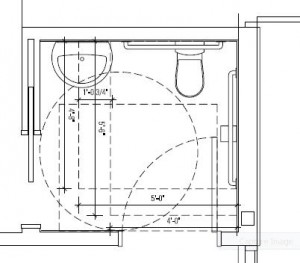
The plan above shows a swing door and a sliding door in the same restroom. The rules for sliding doors are the same as a swing door.
In a toilet compartment, the door swing cannot overlap the floor clearance of the water closet. If the door swings into the clearance of a water closet inside the compartment will impede maneuvering inside the compartment.
604.8.1.1 Size. Wheelchair accessible compartments shall be 60 inches (1525 mm) wide minimum measured perpendicular to the side wall, and 56 inches (1420 mm) deep minimum for wall hung water closets and 59 inches (1500 mm) deep minimum for floor mounted water closets measured perpendicular to the rear wall
604.8.1.2 Doors. …….Toilet compartment doors shall not swing into the minimum required compartment area
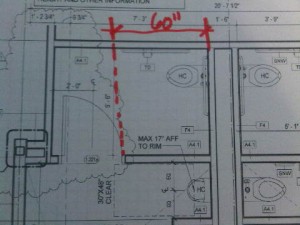
The clearance of the water closet in a compartment should be either 56″ for a wall hung or 59″ if it’s floor mounted. The door can swing out and can also swing in, but the door may not swing into that minimum clearance.
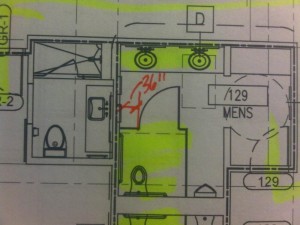
The toilet compartment door shown in the drawing above is swinging into the clearance of the lavatory. Toilet compartment doors must also meet the requirements for section 404 for maneuvering, but there is no restriction to swinging the door into the facing fixtures. That requirements is for the entry door to the toilet room.
What is allowed to overlap in a restroom?
In a toilet room, the floor space and other clearances including the turning space can overlap each other.
603.2.2 Overlap. Required clear floor spaces, clearance at fixtures, and turning space shall be permitted to overlap.

The required clearance around the water closet shall be permitted to overlap the water closet, associated grab bars, dispensers, sanitary napkin disposal units, coat hooks, shelves, accessible routes, clear floor space and clearances required at other fixtures, and the turning space.
No other fixtures or obstructions shall be located within the required water closet clearance.
The photo above shows a floor clearance of 60″ at the water closet, but there is a paper towel dispenser that is within. That dispenser is not allowed to overlap the clearance.
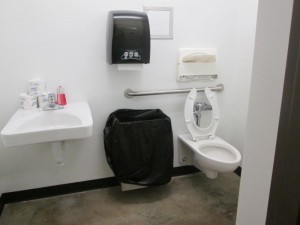
The photo above shows the lavatory within the clearance of the water closet, but in addition there is a fixed trash can and paper towel dispensers within the floor clearance. This is not acceptable.
There is one exception, and that is in residential dwelling units. But this is not for a Fair Housing or ANSI Residential unit. This is the residential dwellings that are scoped in the ADA such as faculty and director apartments in places of education and sleeping quarters in emergency personnel faciliities.
EXCEPTION: In residential dwelling units, a lavatory complying with 606 shall be permitted on the rear wall 18 inches (455 mm) minimum from the water closet centerline where the clearance at the water closet is 66 inches (1675 mm) minimum measured perpendicular from the rear wall.
Need CEUs
If you are interested in Building Code seminars check out my colleague Shahla Layendecker with
SSTL CodesIf you want to learn more about these standards, be sure to check out my books:
Monday, August 3rd, 2015
July 26th, 2015 was the 25th anniversary of the ADA. On July 23rd the AIA Dallas organized an awareness day exercise called “Wheelchair in A Day” where we asked 10 architects to sit in a wheelchair and record their experiences throughout the day. The day was a huge success and the stories they retold were so important. This newsletter will give you a few examples of the participants.

Thank you to Bob Bullis, AIA; Beth Brandt, AIA; Daivd Dillard, FAIA; Bob Borson, AIA; Peter Darby AIA, Laurel Stone, Amanda Adler, Jason Dugas, AIA for participating and for sharing your experience with the rest of us!
Traveling by Airplane on a wheelchair
AIA Dallas President Bob Bullis, AIA participated in the “Wheelchair for a Day” event. He had a meeting in Houston which he decided to keep. So he flew in his wheelchair and tweeted about his experience. We asked him what was his biggest challenge. He told us about his trials with TSA….and I will not get into the “search” pat down he received…Southwest Airlines was very accommodating, and allowed him to remain in the chair so he could experience what it was like. He got to go to the front of the line and board first.

He liked the feel of the Terrazzo flooring the best….easier to push on. But noticed that even the slightest slope was hard to navigate


Being in the office and going out to lunch
Two architects experienced their day in a wheelchair: Bob Borson, AIA and David Dillard, FAIA
Bob Borson, AIA experienced his day in the office doing his typical duties: making copies, taking drawings from his car to his desk, and even going out to lunch. All a very eye opening experiences….read his blog post for a more detailed account
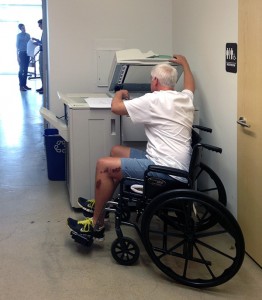
I bet Bob was glad that the doors of his office had the proper widths and maneuvering clearances

When Bob wen out to lunch here is what he experienced
“Next challenge? Going out to lunch. Again, long arms to the rescue, but I am acutely aware of how freakishly long my arms are and as a result, I am acutely aware of how difficult going through a cafeteria line would be for people who don’t have the physical proportions of a simian. “

Taking the tray back to his table was a big challenge…glad he didn’t drop his food!

when he got to his table he noticed that there was no place for a wheelchair except at the end….he made everyone move and find a better table (It’s good to be the boss)
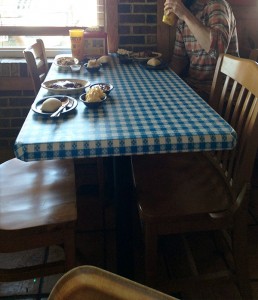
David Dillard, FAIA also stayed in his office and also experienced his daily routine in a wheelchair. Meetings are easier when you are the designer of the office and make accommodations…Good job David!
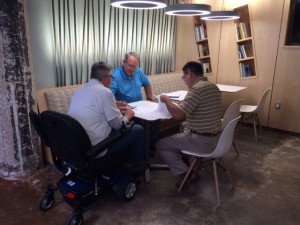
David also had doors he had to maneuver…although his experience was different since he had an electric wheelchair
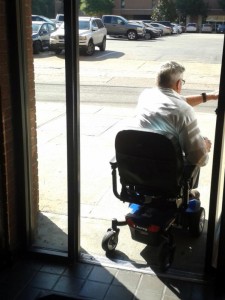
The City of Dallas didn’t plan properly the locations of stop signs and fire hydrants. David found them right in the middle of his accessible route. I bet those were fun to maneuver.

At lunch they found a restaurant with a wheelchair lift that accommodated him so he could dine with his colleagues
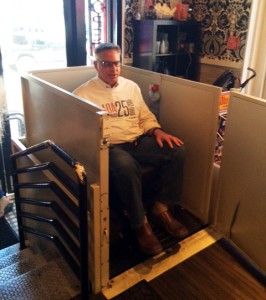
Experiences like these makes architects and designers more sensitive to the people they are designing for.
Taking public transportation
The last example was of our friend Peter Darby, AIA who decided to spend his day in a wheelchair navigating the public transportation system in the City of Dallas
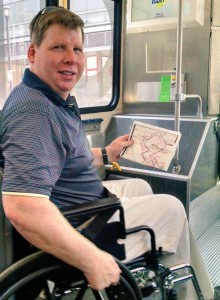
Peter rode in buses, light rail, taxis and even Uber
“Quite a few impediments today. Blocked, Crooked pavements or sidewalks to nowhere! “

He experienced getting onto light rail via ramps
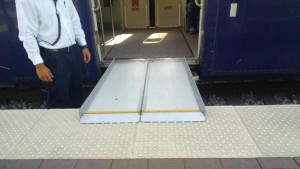
And buses
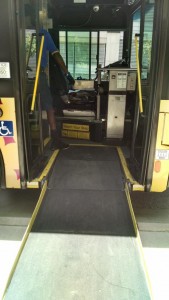
Getting assistance from rail operators

It takes so much longer to get from point A to point B when you are in a wheelchair taking public transportation, but most people with disabilities, especially visually impaired people use public transportation to get around. It is so important that we have these accommodations to enable them to be independent and as sense of dignity and empowerment.
Upcoming Continuing Education Opportunities
August 7, 2015 Accessibility Professionals Association Regional training Plano, Texas
8:00 – 10:00 am- Difference between TAS and ADA Standards- 2 CE/LU/HSW
10:15 am -11:15 pm- Retail Stores and Spaces- TDLR 1 CE #13464, AIA #155 1 LU/HSW- Detail Review of Retail Spaces Barrier Removal;Common errors; Path of Travel Requirements; Retail Accessible Parking and Accessible Routes,
An ADA Case Study of Existing & Remodeled Interiors
11:00 a.m. and 1:00PM
If you are interested in Building Code seminars check out my colleague Shahla Layendecker with SSTL Codes
If you want to learn more about these standards, be sure to check out my books:
“The ADA Companion Guide” “Applying the ADA” published by Wiley.
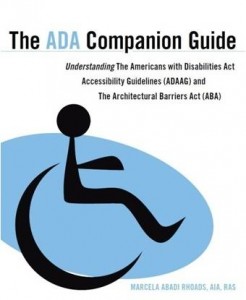
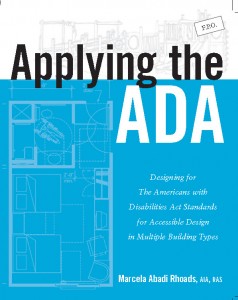
They are available for sale now. (also available as an e-book)
If you have any questions about these or any other topics, please feel free to contact me anytime.
Marcela Abadi Rhoads, RAS #240
Abadi Accessibility
214. 403.8714
marhoads@abadiaccess.com
www.abadiaccess.com
Useful Links

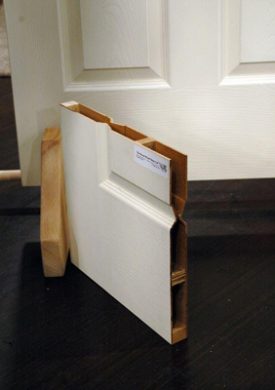
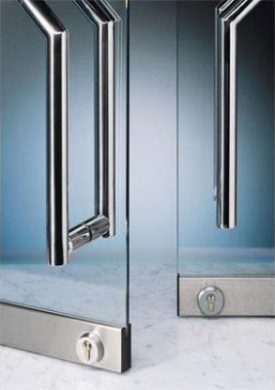
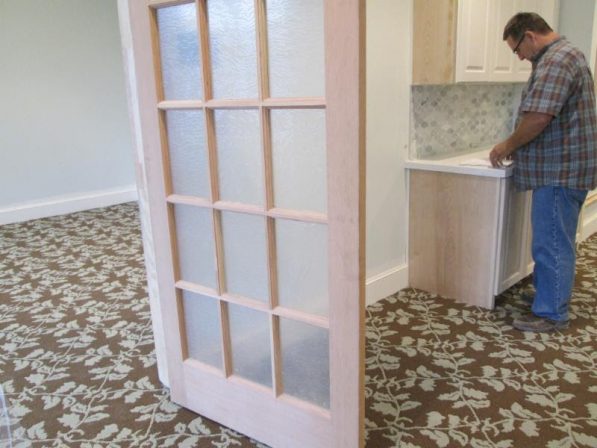


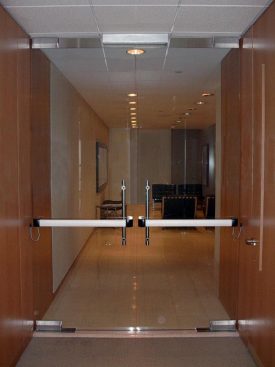




 Abadi
Abadi 

